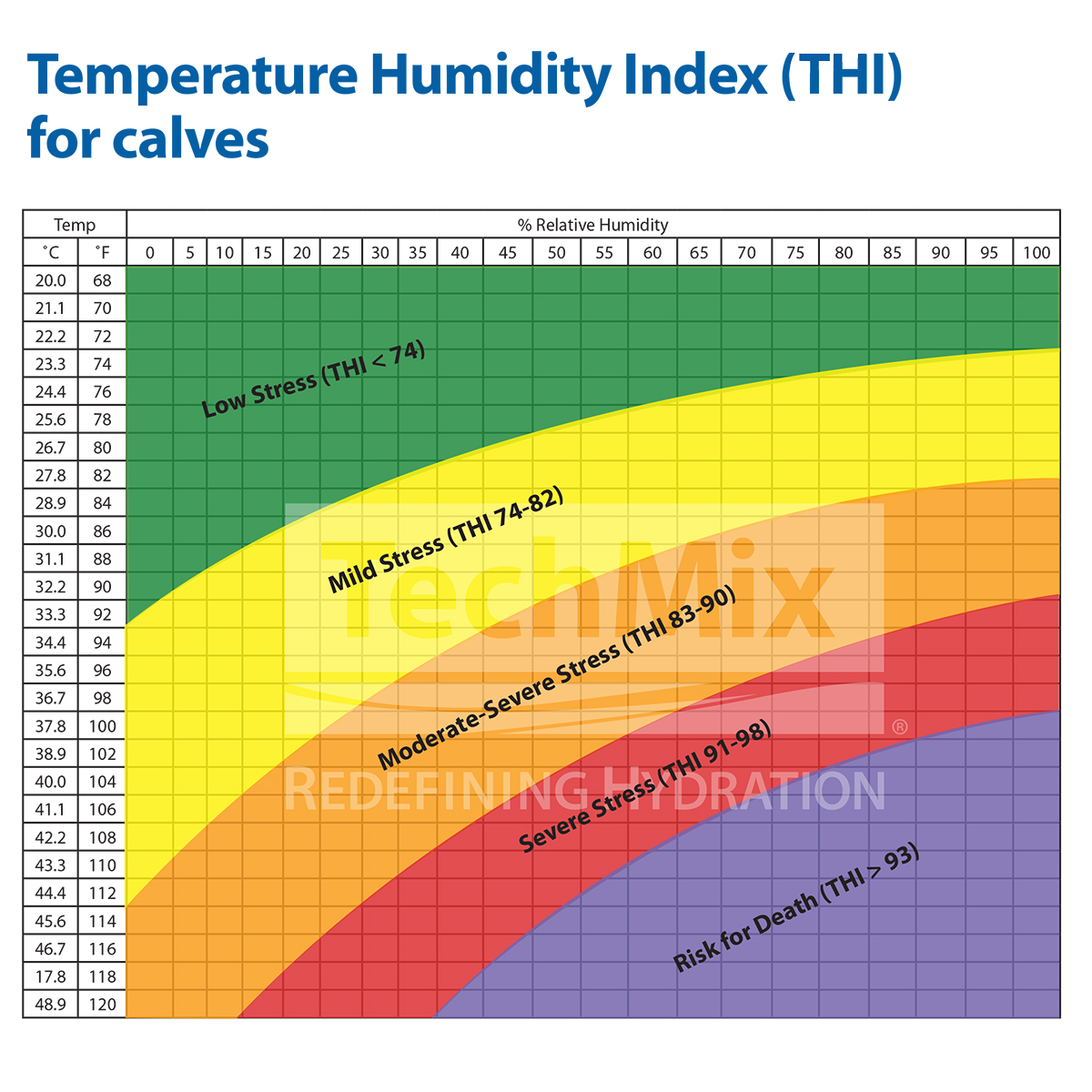Calves under the sun: Navigating heatstress challenges
By Rodrigo Garcia, TechMix international ruminant nutrition manager
Heat stress can have lifelong negative impacts on calf health and performance. Shade, air flow, the THI chart and electrolytes are all essential tools for mitigating this issue.
As the temperatures soar, managing heat stress in dairy and beef calves becomes key for ensuring the health and future productivity of the herd. Heat stress not only affects the immediate well-being of the animals but can also have long-term implications for their growth and development.
The Temperature-Humidity Index (THI) chart for calves is a foundational tool that provides a valuable snapshot of potentially heat-stressed calves. However, it’s equally crucial to complement it with hands-on strategies that go beyond mere observation.
Calves are particularly vulnerable to heat stress due to their limited ability to regulate body temperature efficiently. On the other hand, calves may indeed handle warmer temperatures better than adult cows due to their larger surface area relative to bodyweight and lower heat production. When environmental temperatures rise and are coupled with high humidity, calves experience increased heat load, leading to physiological and metabolic challenges.Signs of heat stress include excessive panting, drooling, reduced feed intake and lethargy.Prolonged exposure to heat stress can compromise immune function, intestinal morphology, hinder weight gain and even lead to long-term health issues.
How hot is too hot?
Calves and heifers experience heat stress when ambient temperatures rise above their thermo neutral zone. Most recent studies show that calves might struggle to dissipate accumulated heat when daily temperatures in calf housing exceed 75ºF to 77°F (24ºF to 25°C).Therefore, when combined with high relative humidity conditions (over 60%), the THI thresh-old would be 74.
THI is a value that combines air temperature and humidity to measure the level of potential heat stress (Table 1). It helps us understand how uncomfortable it feels due to heat in warm weather.

How is heat affecting heifers?
During heat stress, calves and heifers redistribute energy to regulate body heat. This affects dry matter intake (DMI) and growth due to elevated blood insulin levels and protein breakdown.
Heat stress also leads to increased respiration rate and panting, causing larger CO₂ loss.This affects blood acid-base chemistry, resulting in respiratory alkalosis.
Additionally, heat stress preweaning leads to altered lying behaviors in dairy calves overnight.
In young stock with a developed rumen, motility and microbiota could also be affected, disturbing feed digestibility and rumen fermentation. However, some studies suggest that heat stress may not have a measurable effect on nutrient digestibility, indicating that the impact might vary depending on the severity and duration of the stress.
Researchers from Wisconsin and Florida recently demonstrated the long-lasting effects of in utero heat-stressed calves. Those calves weigh less at birth and up to 1 year old, have com-promised metabolism and immune function, will produce less milk across multiple lactations and have a lower herd survival rate.
Provide shade and maximize airflow
Ensuring access to shade in the outdoor pens of the hutches is essential. Calves should have sheltered areas where they can escape direct sunlight during the hottest parts of the day. The inside of hutches under sunlight could become essentially an oven with high moisture and reduced airflow. A simple shade about 3 to 6 feet (1 to 2 meters) above the hutch will reduce the inside temperature and the calf’s body temperatures.
Calf monitoring
Monitoring THI of the calf environment is a crucial first step, but modern technologies allow us to monitor individual calf behavior too, as happens in adult cattle. Several wearable monitoring systems can record respiration rate, activity and body temperature and use that information to help identify heat stress in calves and minimize growth losses.
Fresh water and electrolytes
Often producers understand the need for water and electrolytes, but unfortunately many still don’t execute on this. Do not be afraid of offering electrolytes to calves during hot conditions. They will pay back with higher growth and less disease. Electrolyte solutions offer much more than simple fresh water. They help replenish sodium, potassium and chloride lost during panting for heat dissipation, and stimulate water and solid feed intake.
To improve intake and absorption, electrolyte solutions should be fed at body temperature –even during hot-weather conditions.
Educate your farm personnel
The forefront of calf care is the people spending time with calves. Investing in training the farm caregivers to increase their knowledge of heat stress signs in calves, identifying animals in need of help and taking immediate action is critical. Interpreting data from environ-mental and calf monitoring systems plays a crucial role in implementing timely interventions.
The battle against heat stress in dairy calves demands a proactive and comprehensive approach. By optimizing housing conditions, managing water and nutrition, and closely monitoring environmental factors, producers can safeguard the well-being of their calves and pro-mote optimal growth and productivity. Remember, a well-managed herd is a resilient and productive one, capable of thriving even in the face of challenging conditions.
Tips for providing airflow
1. Consider dominant winds when positioning hutches and maximize ventilation by allowingample space between them, with a recommended distance of 4 feet apart and 10 feet be-tween rows.
2. Raise the rear of the hutch using blocks. This elevation may help improve air circulation.
3. In calf barns, build upon the concept of “adequate ventilation” by incorporating precisionventilation systems. Utilize technology to automate sidewall curtains and fans based on real-time environmental data (THI), ensuring optimal airflow in all conditions.
Article first published in AG Proud. Read the original article here.
